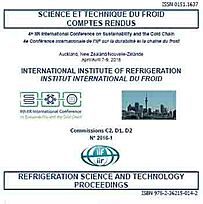
Document IIF
Comparaison entre un système frigorifique hybride à absorption double effet avec déshumidification de l'air préalable et un système frigorifique classique à compression.
Hybrid double effect absorption refrigeration system with a preceded air dehumidification compared to a conventional compression refrigeration system.
Résumé
In cold store refrigeration, depending on the ambient conditions a considerable part of the energy input is required to remove the latent heat, thus, to dehumidify the air. Separating the sensible cooling of the air from the removal of the latent cooling load in a two-stage absorption process bears the potential to increase energy efficiency significantly if dehumidification is driven by part of the heat rejected from the cooling.
To investigate this process, a closed absorption chiller combined with an open absorption liquid desiccant system is build up at TU Berlin. Measurements conducted at this test-rig are compared to a parameter study of an electrically driven compression refrigerating system. Both processes are evaluated regarding its primary energy consumption.
The analysis reveals boundary conditions under which the absorption process could reduce primary energy consumption of cold storages and thus, could increase the economic viability.
Documents disponibles
Format PDF
Pages : 8
Disponible
Prix public
20 €
Prix membre*
Gratuit
* meilleur tarif applicable selon le type d'adhésion (voir le détail des avantages des adhésions individuelles et collectives)
Détails
- Titre original : Hybrid double effect absorption refrigeration system with a preceded air dehumidification compared to a conventional compression refrigeration system.
- Identifiant de la fiche : 30017500
- Langues : Anglais
- Source : 4th IIR International Conference on Sustainability and the Cold Chain. Proceedings: Auckland, New Zealand, April 7-9, 2016.
- Date d'édition : 07/04/2016
- DOI : http://dx.doi.org/10.18462/iir.iccc.2016.0062
Liens
Voir d'autres communications du même compte rendu (63)
Voir le compte rendu de la conférence
Indexation
-
Thèmes :
Systèmes à compression;
Entrepôts frigorifiques : fonctionnement, régulation et sécurité;
Systèmes à absorption et adsorption - Mots-clés : Système frigorifique; Déshumidification; Comparaison; Refroidisseur; Absorption; Système hybride; Entrepôt frigorifique; Efficacité énergétique; Déshydratant
-
Comparison of CO2-glycol-ammonia cas...
- Auteurs : OLIVER G.
- Date : 31/07/2020
- Langues : Anglais
- Source : IIR Rankine Conference 2020.
- Formats : PDF
Voir la fiche
-
Investigation of a liquid desiccant system for ...
- Auteurs : ZEGENHAGEN M. T., KÜHN R., MEYER T., et al.
- Date : 16/08/2015
- Langues : Anglais
- Source : Proceedings of the 24th IIR International Congress of Refrigeration: Yokohama, Japan, August 16-22, 2015.
- Formats : PDF
Voir la fiche
-
Specific energy consumption values for various ...
- Auteurs : EVANS J., FOSTER A., HUET J. M., et al.
- Date : 16/08/2015
- Langues : Anglais
- Source : Proceedings of the 24th IIR International Congress of Refrigeration: Yokohama, Japan, August 16-22, 2015.
- Formats : PDF
Voir la fiche
-
Energy consumption comparison of NH3/CO2 and am...
- Auteurs : LAMB R.
- Date : 25/02/2008
- Langues : Anglais
- Source : 11th European Cold Chain Education Program. Presentations [CD-ROM].
Voir la fiche
-
A new defrosting method using the thermosyphon ...
- Auteurs : MUGABI N., KAYASHIMA D., YOSHIKAWA C.
- Date : 18/06/2018
- Langues : Anglais
- Source : 13th IIR Gustav Lorentzen Conference on Natural Refrigerants (GL2018). Proceedings. Valencia, Spain, June 18-20th 2018.
- Formats : PDF
Voir la fiche
